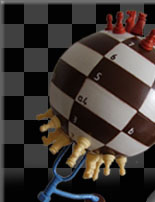 |
| The game flows on annular ranks,
annular diagonals and annular files (64 squares are used fully
and 2 squares partially). The pieces can pass symmetrically
over squares X and Y, but can’t be positioned on these squares.
In this version of the game the polar squares (squares X,
Y) behave as neutral squares. Even though they exist, they
are not used in practice (pieces cannot step on them).
Compared to the first version of the game now even the lower
and upper edge of the chessboard disappear (next to squares
X and Y), consequently the movement of pieces is unobstructed
even in vertical direction. A new opportunity is
to move from the first square to the first square of the
opposite
file, or from the last square to the last square of the opposite
file. Thereby the edges and corners of the traditional board
are removed from every side and as a result of this the power
of the pieces is enhanced in vertical, horizontal and diagonal
direction. From now on, the movement of pieces can only be
hindered by each other. In the optimal version of Globe – chess all
unfavourrable effects of the traditional chessboard are
eliminated, but
a new positive effect is created with the 2 neutral squares! (an opportunity to pass over the polar squares). The function
of the neutral squares enables further development of the
agility of pieces. The opponent’s pieces can be attacked
from any direction – meaning around the sphere, from left
and right, up and down – within the observance of rules.
Every square has its neighbouring squares. All the 64 squares
could be regarded as central squares of equal value and therefore
the pieces can move in optimal conditions exerting their
maximum influence. The difference in the value of the respective
squares (which depends on the current position on the board)
can be modified only by the strength and potential of the
pieces. This is a great development compared to the classic
board, where these differences in value originate in the
effect caused by the edges and corners of the board! (The
closer we get to the edge or corner of the board the worse
our position gets).
On the traditional board the target square can be reached
from a given square from only one direction, e. g. the rook,
the bishop and the queen can attack or defend a square using
only one route.
On the other hand, these goals can be achieved using several
routes on the chess – sphere. The easiest way is to use 2
routes, but it is also possible to create 4 routes on the
four sides of the sphere. The queen’s combined movement (rook
– bishop) further enhances the number of possible routes.
|
|
|
The rook (figure nr. 8)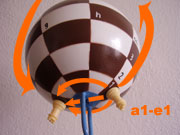
The rook moves on vertical files (across neutral squares) upwards (Ra1 – a2, a3, a4, a5, a6, a7, a8, Y, e8, e7, e6, e5, e4, e3,
e2, e1, X) and downwards (Ra1 – X – e1, e2, e3, e4, e5, e6, e7,
e8, Y, a8, a7, a6, a5, a4, a3, a2).
On horizontal ranks the rook moves around the sphere to the right (Ra1 – b1, c1, d1, e1, f1, g1, h1) or to the left (Ra1 – h1,
g1, f1, e1, d1, c1, b1).
A given square can be reached from two directions on every rank
and file. The rook on a1 can reach the opposite square e1 using four
different routes. In case of annular movement empty ranks
and files are required. A rook can check the enemy king from
four different directions, from left and right (horizontally),
upwards and downwards (vertically).
|
|
The bishop (figure
nr. 9)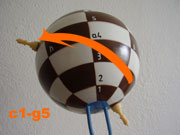 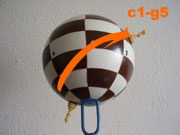
The bishop moves on diagonals of a given color.
Compared to the classic game its value has enhanced,
because it can symmetrically pass over the neutral
polar squares and cross the invisible border
between the a) and h) files. The bishop moves
in an „S“ pattern over the polar squares.
The path of the bishop from c1 to the right is
as follows: Bc1-d2, e3, f4, g5, h6, a7, b8, Y,
f8, e7, d6, c5, b4, a3, h2, g1, X, c1. The bishop
always steps diagonally to the next square to
the right. This way it reaches b8, symmetrically
passes over square Y to the f8 square and turning
to the right it continues to g1. Its path seen
from above resembles a big S letter.
The second option is going to the left from c1
to g1: Bc1 – b2, a3, h4, g5, f6, e7, d8, Y, h8,
a7, b6, c5, d4, e3, f2, g1, X. Over square d8
symmetrically passes over the neutral square
to the h8 square and continues to the left. Its
path seen from above resembles a big inverted
S letter.
The two routes cross each other on
6 squares and meet on one square: e3, g5,
a7, e7, c5,
a3, g1. Starting from the first rank they diverge
left and right, on the 3., 5. and 7. rank they
cross each other in a right angle and meet
again on g1.
These intersections appear where the two big
S letters cross each other. Attacking, reinforcement
and checking (double check) is possible only
on a free diagonal.
In the opposite direction the route passes
over the neutral square X to the g1 square,
here the route splits left and right and reaches
the named squares from the opposite direction.
This way it is possible to deliver quadruple
check (or checkmate) at the same time on the
highlighted squares of the 3., 5. and 7. rank.
Attention: A piece of the opponent can be captured
only once. If three of four diagonals are closed
by other pieces, it is still possible to attack
or defend on the remaining diagonal. The only
option in classic chess turns into four on
the chess – sphere!
The ability of the bishop to attack a square
using four different diagonals is a revolutionary
concept in the history of chess, the grasping
and utilization of which is the alpha and omega
of the new game.
|
|
The queen (figure
nr. 10) 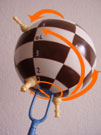 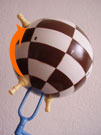
The queen moves on the sphere like the bishop and the rook combined. From the first rank it
exerts its influence over 21 squares if it moves
like a rook, but the queen can reach 23 additional
squares moving like a bishop. This way the queen
is the piece with the greatest power. In
case of Qd1 the powers of rook and bishop are
combined
in one piece and the route meets on 3 middle
squares (besides the neutral squares): d5, Y,
h5, h1, X. For the queen on d1 these squares
are of a strategical importance. Naturally, depending
on the movement of the queen, these meeting points
vary. |
|
The knight (figure
nr. 11)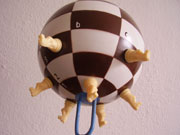 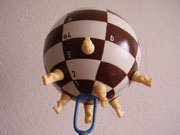
The knight on b1 can reach the following six
squares: a3, c3, h2, d2, g1,
e1. The power of
the knight has also increased on the chess –
sphere, because on the classic board it couldn’t
reach h2 and over the neutral squares g1 and
e1. For example Nb1 – X – e1, Nb1-X-g1.
The knight on b1 symmetrically passes over the
polar square (in the direction of the opposite
file) as follows: 1: X, 2: f1, 3:
e1 or g1. These
two possibilities provide the knight great defensive
capabilities. Even though its a short – range
unit, its strength (near the polar square)
lies in the fact, that it can be captured only
by
a piece of a higher value. The knight can close
down gaps in the defence before the enemy queen,
bishop or rook.
|
|
The king (figure nr.
12)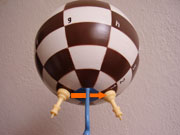
The king can move to any adjacent square, if it’s not occupied
by another piece of the player or is not attacked by an enemy
piece. The king can move one square in any direction. It can
pass over the neutral X and Y polar squares , if they’re not
attacked
by enemy units.
The king cannot move to the polar square, so from the starting
square it moves to the first rank of the opposite file, for instance
Ke1 – X – a1. It goes to a1 without castling, so he can also
escape in a vertical direction. He can reach the opposite vacant
square with a move equal to castling. This variation of Globe
– chess gives optimal capabilities to the king.
|
|
Castling (figure
nr. 13)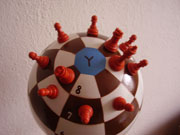
A new option is, that if the knights, bishops
(and the queen) leave the first or the eighth
rank, the position after castling occurs aically
(on the free annular rank). The position is then
Ra1 – Ke1 – Rh1. This natural annular position
gives the king protection from both sides.
On the annular first rank the king can
castle either side, with either of the rooks. (On the
left or right side with a rook that hasn’t moved
yet).
|
|
The
pawn (figure nr. 14)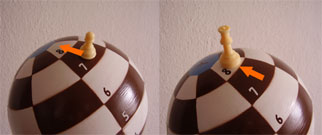
If the pawn reaches the last rank (for white
it is the eighth, for black the first rank),
it is promoted to a chosen piece of the same
color, except for the king. This new piece is
immediately ready for action. The pawn cannot
step on the X and Y polar squares, nor can it
pass over them. |
|
|
|
|
